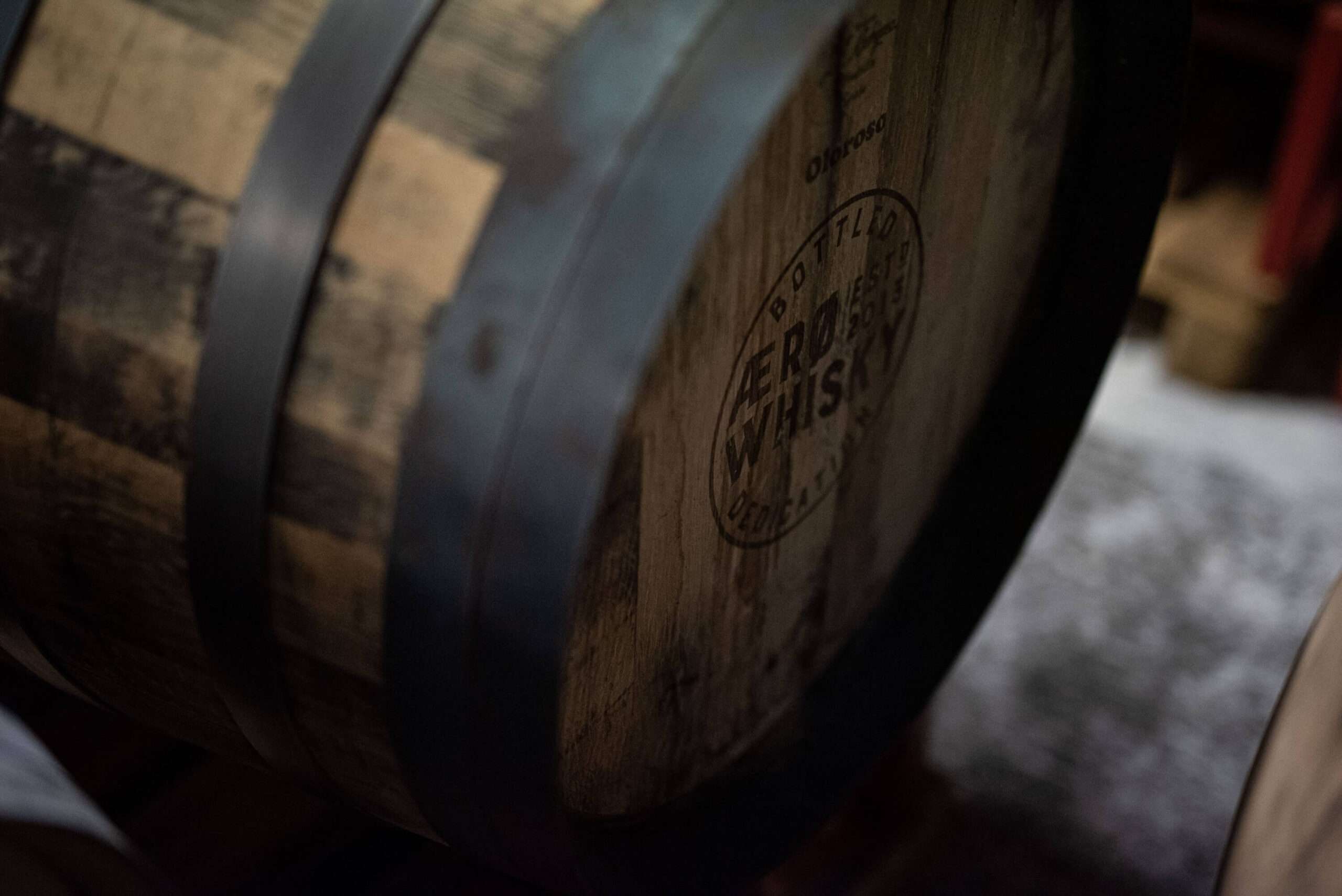INTRODUCTION TO WHISKY
“TheScotch Whisky Act 1988is a law that regulates the production of Scotch whisky. Before it can be called Whisky, it must be aged for at least 3 years in an oak cask. The cask can be new, but in practice, sherry has usually been aged in the cask before the whisky is poured. The most common today is to use casks that have held American bourbon whiskey or Spanish sherry. Furthermore, the bottled product must contain a minimum of 40% alcohol. Ærø Whisky actually uses 4 types of casks: new Hungarian oak, olorosso casks, PX casks and casks made from local Ærø oak.
ÆRØ WHISKY
At Ærø Whisky, we only make single malt whisky. Single Malt means that the whisky is made from a single batch of 100% malted barley and in a single distillery.
Malt, or barley malt, is simply pre-germinated and dried barley and is the fundamental raw material for whisky.
Barley has a natural starch content, which is found in small starch granules in the seed white. The barley Ærø Whisky uses in its production differs from regular barley by having a high starch content. The starch is broken down into malt sugar, which is converted into alcohol during fermentation. In order for the malt sugar to become available to the yeast, the starch in the barley grains must first be released and broken down. Then the yeast can start making alcohol.
The malt is produced in three steps: molding, malting, drying. The malt is then crushed and mixed with water to start the mashing process. This solution is filtered. The result of these processes is the ‘wort’, which after fermentation is distilled.
MOlDING
During molding, the barley kernels are soaked in water and they absorb water until the moisture content reaches approximately 42-48%. When the water content reaches this level, the germ will start producing a hormone called gibberellic acid. Gibberellic acid is the initiator of germination in the grain. The hormone is transported to the aleurone cells, where it initiates the production of a number of enzymes.
MALTING
Malting is thus an expression of the controlled germination of barley kernels that takes place on the malting floor in Ærø Whisky’s brewery. After molding, the barley kernels are allowed to continue to germinate until we see the germ start to protrude from the barley kernel. Ærø Whisky malts approx. 600 kg. at a time under consistent conditions. The kernels are turned continuously to allow them to germinate separately. If the roots are not turned, they risk becoming entangled and can be very difficult to separate. As a natural part of the germination process, the aleurone layer and germ produce enzymes that are able to break down the nutrient reserves (starch and protein) stored in the seed white.
The starch grains are surrounded by a protein matrix that needs to be broken down by proteases. Proteases are enzymes that break down proteins by cleaving their peptide bonds. These are formed in the aleurone and scutellum layers before the starch-degrading enzymes can access the starch. In addition, the seed white contains, among other things, β-glucans, which are structural components of the cell wall of the seed white.
Two important starch-degrading enzymes are active during malting: α-amylase and β-amylase. The α-amylase is formed during germination in the aleurone layer; the α-amylase, on the other hand, is an inactive enzyme in the seed coat of the barley kernel, but is activated during germination. The two enzymes have different functions, with α-amylase cutting the long starch molecules into smaller pieces of varying lengths, whereas β-amylase releases two contiguous glucose molecules from each of the long starch molecules. The difference is that α-amylase is an endoamylase and hydrolyzes α-1,4 bonds inside the starch molecule, while β-amylase is an exoamylase that hydrolyzes α-1,4 bonds from the non-reducing end of the starch molecule by releasing malt sugar (also called maltose).
In addition to α-amylase and β-amylase, β-glucanases are also formed to break down the β-glucans in the cell walls of the seed white. As the cell walls break down, this means that the amylases have easier access to the starch granules. In addition to giving the amylases easier access to the starch, it is very important that a large part of the β-glucans in the seed white are removed before filtering the beer wort, as too high amounts of β-glucans cause slow filtration. When β-glucans dissolve in water, a highly viscous (viscous) solution is formed, which can clog the filter.
The production of malt mimics the germination that takes place in barley grains when they are sown in the field in the spring. When the barley grains in the soil absorb water due to soil moisture, the germ will produce the hormone gibberellin, which initiates the germination process. α-amylase is formed in the aleurone layer and β-amylases are activated to break down the starch in the seed coat – and proteases form amino acids and small peptides. The germ uses the energy in the broken down starch and protein to germinate. When the first green leaf sees the surface of the soil, energy from the broken down starch and protein is no longer needed as the plant can now perform photosynthesis. The seed white can thus be seen as the barley kernel’s “lunch box” and used as energy when spring arrives.
It’s important that the malting plant stops germination after five days, otherwise the starch will be used to form sprouts and roots, which is not a good idea when you’re interested in brewing as much wort for whisky as possible.
DRYING
After germination, the kernels are dried with heat from the underfloor heating in the malting floor and hot air from heat guns (also known as kiln drying). We do this process completely manually, just like in the old days. The difference is that Ærø Whisky does not use an open fire for this process, but rather heat from electricity. Originally, the drying was done over a peat fire, which contributed to the smoky whisky flavor. We use a large oak shovel and turn the core about 6-8 times a day. The process of turning the cores is important to avoid mold formation, as well as to ensure uniform drying and avoid the roots/sprouts becoming entangled.
- The water is heated to 50°C and malt is added. The liquid then ‘boils’ (approx. 40 min. rest)
- Heating to approx. 64°C to allow β-glucanases, β-amylases and proteases to work (45 minutes rest)
- further heating to 72° C to allow the α-amylases to work (approx. 15 min rest)
- Finally, de-mash at 78°C to break down the last of the starch in the solution. (approx. 2 min. rest)
- Main fermentation: glucose and maltose
- Secondary fermentation: maltotriose
DISTILLATION
Distillation is a method of separating liquids with different boiling points. The separation is done by heating the mixture in a container until one of the substances evaporates. The steam is cooled to liquefaction and the condensate is collected in a separate container.
The distillation method itself hasn’t changed significantly after centuries. When distilling whisky, it’s important that the master distiller takes care to preserve the flavor of the malted barley and the wort. You could say that the more contact the alcohol has with its boiler, the more flavor it will achieve. The copper that the kettle is constructed from acts as a catalyst for many of the chemical reactions that take place during distillation. The boiler both releases flavor and removes unwanted flavors such as sulfur.
The distillation plant at Ærø Whisky is a hand-built German plant from Müller in Oberkirch. The plant is a double distillery in a closed circuit. The process begins with the ‘wort’ being pumped from the fermentation tank into the first part of the distillation plant. This part is a so-called ‘pot-still’ that most people will recognize. A pot-still, although they can look very different, has a large boiling kettle at the bottom and a distinctive ‘onion’ at the top, leading to a gooseneck. In this part of the process, we capture all the aromatic substances in the herb. To put it simply, the distillate the pot-still produces is not a pure product, which is why the flavors are retained. The wort will now be distilled to around 30-35% alcohol and sent through a closed circuit to the second part of the process – the column still.
In the column section begins what is known as continuous distillation, which was patented by Aeneas Coffey in 1830.
In practical terms, the herb received from our pot-still is directed to the bottom of the column. Inside the column are 5 copper plates through which the hot alcohol vapors must pass. At the bottom, the temperature will be 100-110 degrees, but only 80 degrees at the top. This, along with the layers up through the column’s 5 copper plates, ensures that only the alcohol vapors leave the column. The many layers in the column mean that the vapors are condensed and have to evaporate again to get to the next layer. The advantage of a column distiller is that you can achieve a very high alcohol percentage (in Ærø Whisky an average of 88%), which results in a much cleaner product.
The result of any distillation is divided into three separate parts: the head, the heart and the tail. The best and desired portion of the distillation is obtained from the heart.
The transition between the three parts of the distillate is up to the distiller to decide. The trick is knowing when to start collecting the heart and when to stop again. Ærø Whisky’s experienced distillers use their senses to determine where the transitions are. Of course, we are also helped by a knowledge of temperatures.
The head, or head, can be both tasted and smelled. It usually has a very pungent taste and is malodorous as it contains a combination of acetone, methyl alcohol, methanol and ethyl acetate. This part of the distillate is highly toxic and is always thrown away. In a batch of 650 liters of wort, about 4 liters are directly discarded. The process starts in the Ærø Whicky at approx. 78 degrees and runs to approx. 80 degrees
The heart of the distillation (the ethanol) is always completely transparent and almost odorless. In a 650-liter batch, about 40 liters can be poured into oak barrels to become whisky. The heart starts at about 80 degrees and runs until the temperature reaches about 88 degrees.
The tail contains a large amount of higher boiling point alcohol compounds. These compounds can ruin the taste of the alcohol if left to soak for too long. The transition point to the tail can be identified by the taste, smell and milky cloudiness of the distillate. The tail is stored in a ‘low wine’ vessel and included in the next distillation as it still contains some ethanol. The tail starts at about 88 degrees and runs until we see the alcohol volume drop to about 35% and then the process stops.
AGING IN BARRELS
Some would argue that the positive effect that cask ageing has on whisky was discovered by market traders and nobles who bought large quantities of the spirit at a time and stored it in different wooden casks over the years. Here, it was discovered that the spirit only got better with time, leading to the increased popularity of whisky.
A multitude of different types of barrels have been used to store whiskey and other forms of alcohol over the years. The vast majority of them are still in use today, with a few others. At Ærø Whisky, we have over the years primarily used Spanish sherry casks, but have also experimented with French red wine casks, new American oak, Hungarian oak. The most unique thing we have attempted is the use of local Ærø oak, which has provided the wood for our most unique whisky: Local Oak
SPANISH SHERRY CASKS
Many whisky makers are incredibly enthusiastic about the heavily sweet Andalusian fortified wine; Sherry. There are many different types of Sherry, each with their own characteristics and flavors. They are all used for whisky production, some significantly more than others.
FINO
- A dry fortified wine with a light yellow color.
- Hints of yeast, bread, herbs, almonds and apples
MANZILLA
- A dry fortified wine with a very crisp light color.
- Hints of chamomile, green apples, lemon, olives and maritime influences
AMONTILLADO
- A dry fortified wine with a semi-light amber color
- Hints of hazelnuts, fudge, dried fruit and bread.
PALO CORTADO
- A dry fortified wine with a beautiful chestnut color.
- Hints of orange, walnuts, tobacco and chocolate.
OLOROSSO
- A dry fortified wine with a deep amber color.
- Nuances of coffee, leather, tobacco, dark fruit, truffle, marzipan and roasted nuts.
CREAM SHERRY
- A soft and sweet fortified wine with a dark amber color.
- The nuances are very similar to a sweetened Olorosso.
PEDRO XIMENEZ (PX)
- A sweet and incredibly dark-colored fortified wine.
- Nuances of stone fruit, honey, plums, black currants and sweet licorice.
MOSCATEL
- A sweet and a (typical) medium-light fortified wine. There are also dark variants.
- Nuances of stone fruit, honey, citrus, vanilla and caramel.
Sherry transfers its flavor to whisky incredibly well, which is why it is used so often. In addition to the Spanish sherry casks, casks that have held port, red wine, Cognac, Sauternes and of course American whiskey/bourbon are also used.Traditional port wine casks give a character that is very similar to what you know from Sherry, but roughly speaking with an increased fruitiness and sweetness
FRENCH FADE
Moving up the world map from Spain/Portugal to France, we find some casks that often give more spicy nuances than Sherry/Port.
COGNAC FADE
- Hints of vanilla, toast, chocolate, cedar, cinnamon and nutmeg.
RED WINE (BORDEAUX & BURGUNDY) BARRELS
- Hints of strawberry, raspberry, cherry, coffee, pepper, herbs and licorice.
Sauternes casks
- Nuances of apricot, citrus fruits, honey, pineapple, white pepper and flowers.
AMERICAN BARRELS
Over on the other side of the Atlantic, they also produce very suitable casks for whisky storage. Scotland probably imports an equal amount of casks from here as they do from Spain.
FADE CARTRIDGE
- Nuances of vanilla, caramel, coffee, nutmeg, mild smoke and bananas.
VIRGIN OAK (FRESH UNUSED OAK) BARRELS
- Hints of vanilla, lemon, ginger, pepper and honey.
JAPANESE FADE
In the old days, Japanese whisky production used American and Spanish casks, but today an astonishingly high number of Japanese distilleries have their own cooperages, using Japan’s own oak, Quercus mongolicus, to make these casks. These casks have been given the name: Mizunara casks.
MIZUNARA FADE
- Hints of fruit, incense, cinnamon and coconut.
TOASTING OF DISHES
Common to all casks is the toasting. For cleaning a dish, as well as adding a layer of nuance, roasting is used. Most casks are toasted before they are filled with raw spirits. The degree of roasting is divided into 4 levels, with level 1 being a very mild roast and level 4 being an incredibly hard roast. When roasted at level 4, the wood takes on a furrowed alligator-like texture and gives off some amazingly exciting smoky and spicy nuances. Level 4 toasting is popular with Bourbon whiskey in particular. In Ærø Whsiky, we primarily use a +1 roast. Barrel ageing is one of the most essential things when discussing whisky production. An interesting cask ageing can make a 5-year-old whisky quite engaging, whereas an inactive cask can make a 20-year-old whisky bland. Music is created when great barrel aging, craftsmanship, time and passion come together.



